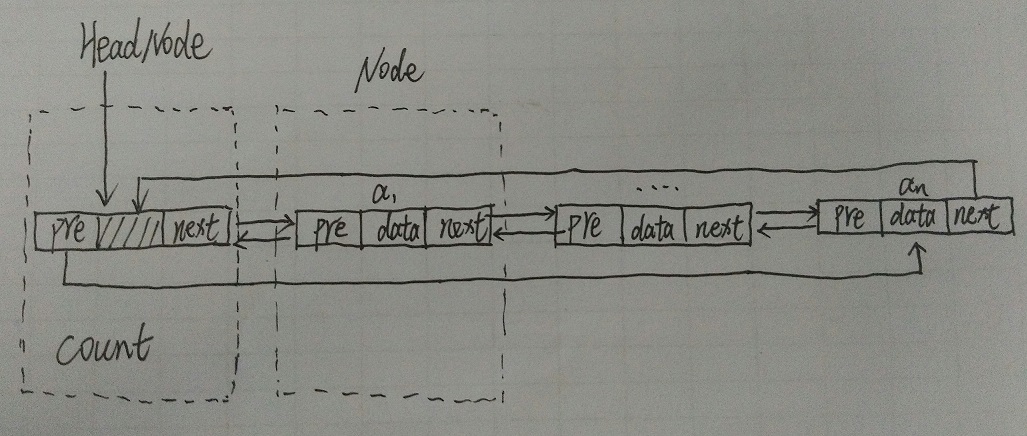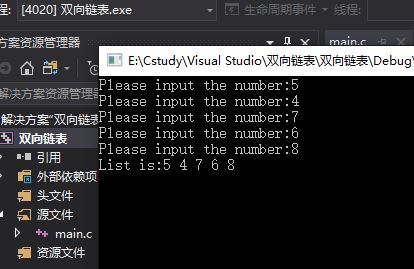在学习RTOS操作系统时,在任务优先级设置时用到了双向链表,说实话数据结构的东西只是停留在大学上课阶段,并未实践过,在操作系统中看得云里雾里,遂将其单独拿来了进行了一下思考,经过一个上午的摸索逐渐领会到了其中的精华。
1.什么是双向链表
百度百科:双向链表也叫双链表,是链表的一种,它的每个数据结点中都有两个指针,分别指向直接后继和直接前驱。所以,从双向链表中的任意一个结点开始,都可以很方便地访问它的前驱结点和后继结点。一般我们都构造双向循环链表。

此表中包含两个重要信息:链表结构,节点结构
首先定义好节点的结构体:
1 typedef struct _tNode 2 { 3 int data; 4 struct _tNode * pre; 5 struct _tNode * next; 6 }tNode;
然后在定义链表的结构体:
1 typedef struct _tList 2 { 3 tNode HeadNode; 4 int NodeCount; 5 }tList;
这个结构体的作用就是可以在工程中创建多个这样的链表结构,结构体里包含头结点HeadNode和此链表节点的数量NodeCount用来对链表进行操作的定位。头结点并不保存数据,只是提供指向节点的指针用来连接整个链表。所以在操作链表时可以很快地进行各种操作。在操作链表时只需要对完成对节点地添加和删除即可,头结点保持不变!
基本初始化:
void tNodeInit(tNode *Node) { Node->pre = Node; Node->next = Node; } void tListInit(tList *list)//初始化链表 { list->HeadNode.pre = &(list->HeadNode); list->HeadNode.next = &(list->HeadNode); list->NodeCount = 0; } int tListCount(tList *list)//返回链表节点数量 { return list->NodeCount; }
节点数据的插入和删除:
tNode* FirstNode(tList *list)//返回首节点 { tNode* node = (tNode*)0; if (list->NodeCount != 0) { node = list->HeadNode.next; } return node; } tNode* LastNode(tList *list)//返回最后一个节点 { tNode* node = (tNode*)0; if (list->NodeCount != 0) { node = list->HeadNode.pre; } return node; } tNode* tListPre(tList* list,tNode* node)//返回一个节点的前一个节点 { if (node->pre == node) { return (tNode*)0; } else { return node->pre; } } tNode* tListNext(tList* list, tNode* node)//返回节点的后一个节点 { if (node->next == node) { return (tNode*)0; } else { return node->next; } } void RemoveAll(tList* list)//删除所有节点 { tNode* CurrentNode, *NextNode; int count; NextNode = list->HeadNode.next; for (count=list->NodeCount;count > 0;count --) { CurrentNode = NextNode; NextNode = CurrentNode->next; CurrentNode->pre = CurrentNode; CurrentNode->next = CurrentNode; } list->HeadNode.pre = &(list->HeadNode); list->HeadNode.next = &(list->HeadNode); list->NodeCount = 0; } void tListHeadAdd(tList *list,tNode *node)//在头部添加节点 { node->next = list->HeadNode.next; node->pre = list->HeadNode.next->pre; list->HeadNode.next = node; list->HeadNode.next->pre = node; list->NodeCount ++; } void tListLastAdd(tList *list,tNode *node)//在最后添加节点 { node->pre = list->HeadNode.pre; node->next = list->HeadNode.pre->next; list->HeadNode.pre->next = node; list->HeadNode.pre = node; list->NodeCount ++; } tNode* RemoveFirstNode(tList *list)//移除第一个节点 { tNode *node = (tNode *)0; if (list->HeadNode.next != 0) { node = list->HeadNode.next; node->next->pre = &(list->HeadNode); list->HeadNode.next = node->next; list->NodeCount --; free(node); } else { return node; } } void tListInsertAfter(tList * list, tNode * nodeAfter, tNode * nodeToInsert)//在一个节点后添加一个节点 { nodeToInsert->next = nodeAfter->next; nodeToInsert->pre = nodeAfter; nodeAfter->next->pre = nodeToInsert; nodeAfter->next = nodeToInsert; list->NodeCount ++; } void tListRemove(tList * list, tNode * node)//移除节点 { node->pre->next = node->next; node->next->pre = node->pre; free(node); list->NodeCount --; }
在这个双向链表的实现过程中可以很好地实现队列操作,先进先出概念如这样验证:
int main() { tList list; tNode *node; int i = 0; tListInit(&list); for (i = 0; i < 5; i++) { node = (tNode*)malloc(sizeof(tNode)); printf("Please input the number:"); scanf_s("%d",&node->data); tListLastAdd(&list, node); } node = FirstNode(&list); printf("List is:"); for (i = 0; i < 5; i++) { printf("%d ",node->data); node = node->next; } printf(" "); getch(); return 0; }
实现效果为:

在这个基础上还可以用于多种其他用处!
PS:今天是自己第一天也是第一次写博客,在实现的过程中遇到很多问题也有很多想法,本来想一一记录但是发现写起来还是很艰辛,也许我现在就是一个小菜鸟,但是希望能够通过自己的努力一点一滴地积累逐渐成长,希望这个博客可以被我一直写下去!
写于广东海悟科技有限公司 2017-11-10 22:29:50